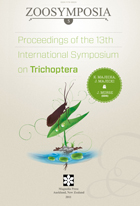Abstract
The limnephilid caddisfly Dicosmoecus gilvipies (Hagen) occurs in many streams of northwestern United States and British Columbia. Because of the large size of the fully grown larva, its synchronous emergence pattern, and its frequent imitation by fly-fishing anglers, D. gilvipes is one of the best known North American aquatic insects. Egg masses are found at the bases of Carex sedges. Cases of early larval instars are made of organic material and detritus; 3rd and 4th instars incorporate pebbles into cases. The 5th-instar case is made entirely of mineral material. Larvae can travel up to 25 m per day, and are predominantly scraper-grazers. Fifth instars attach their cases to the underside of boulders in mid-summer and remain dormant until pupation in autumn. All northern California populations known are univoltine. Adult females use sex pheromones to attract males; most males come to trapped females in the 1st hour after sunset. In laboratory studies, males and females fly during the mate attraction period but generally not at other times. Males but not females exhibit circadian rhythms that govern flight periodicity. In enclosures to study biotic interactions, the density of D. gilvipes larvae has a negative effect on the densities of sessile grazers. This species has been widely used in trophic and behavioral studies conducted in the laboratory and field, and may be a model organism for ecological studies of caddisflies and other benthic macroinvertebrates.

